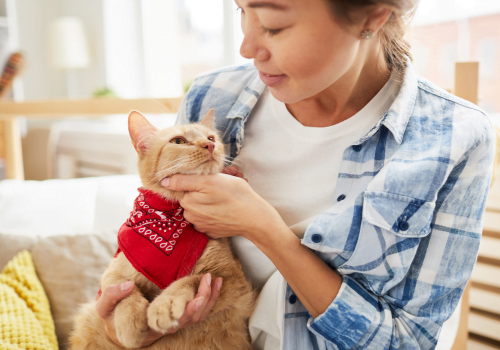Estimated reading time: 4 minutes
If you’ve ever wondered how your cat perceives you, you’re not alone. Many cat owners are curious about how their feline friends see the world, and more specifically, how they see their humans. In this article, we’ll delve into how feline vision works, discuss how cats perceive humans, and offer some tips on building a strong bond with your cat.
How Cats See The World
To understand how cats see us humans, it’s essential to first grasp how they see the world around them. Cats’ visual capabilities differ from those of humans in several key ways.
Color Perception
While cats don’t see the world in black and white, their color vision is not as vivid as ours. Cats have fewer color receptors in their eyes, which means they perceive fewer colors and with less intensity. They can distinguish between blues and greens but may struggle with reds and oranges. Dogs have similar issues, seeing blues and yellows, but not reds and greens.
Night Vision
Cats are nocturnal creatures and have exceptional night vision. Their eyes contain a higher number of rod cells, which are responsible for detecting light and motion. This enables them to see clearly in low-light conditions, giving them a significant advantage when hunting prey at night.
Field of View
Did you know that cats enjoy a wider field of view than humans? The position of their eyes on their head allows them to see more of their surroundings without having to turn their heads. This helps them stay alert and aware of their environment.
How Cats Perceive Humans
Now that we have a basic understanding of feline vision, let’s dive into how cats perceive their human companions.
Recognizing Faces
So, how do cats see human faces? Research shows that cats can recognize their owner’s face, but not as well as dogs can. They might not rely on this ability as much as humans do. Instead, they use other senses like smell and hearing to identify their humans.
Body Language
Cats are masters at reading body language. They can pick up on subtle cues such as posture and movements, allowing them to understand their human’s intentions. This skill is crucial for cats, as it helps them interpret and respond to their owner’s actions.
Voice Recognition
Believe it or not, your cat can probably recognize your voice among others. Studies reveal that cats respond differently to their owner’s voice compared to a stranger’s voice, indicating that they can distinguish between familiar and unfamiliar voices.
How Cats Interpret Human Emotions
Cats are quite sensitive to their owner’s emotions and can often pick up on changes in mood. They may react differently to an owner who is happy or playful compared to one who is sad or stressed. This sensitivity helps create a strong bond between the cat and its owner, as the cat learns to respond appropriately to their human’s emotional state.

Building Bonds with Your Cat
Fostering a strong relationship with your cat involves understanding their behavior, creating a comfortable environment, and effective communication.
Understanding Cat Behavior
Being aware of your cat’s natural instincts and behaviors can help you better understand their needs and preferences. For example, cats are territorial creatures, so providing them with designated spaces in your home can help them feel more secure and comfortable.
Creating a Comfortable Environment
Ensure your cat has access to all the necessary resources, such as food, water, litter boxes, and resting areas. Providing toys and scratching posts can also help keep them entertained and engaged, promoting their overall well-being.
Communicating with Your Cat
Learn to recognize the various sounds and body language cues your cat uses to communicate. Responding appropriately to their needs and signals can help build trust and strengthen your bond. Additionally, using a consistent tone of voice and gentle touch can help your cat feel more at ease around you.
Conclusion
Cats perceive humans differently than we perceive ourselves, using a combination of their unique visual capabilities and other senses to understand and interact with their environment. By understanding how cats see humans and the world around them, we can build stronger relationships with our feline friends.








